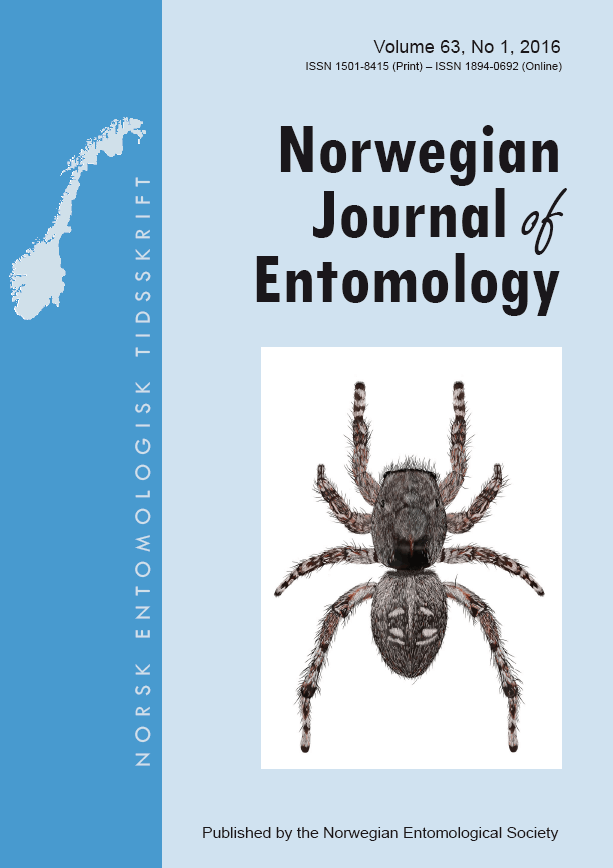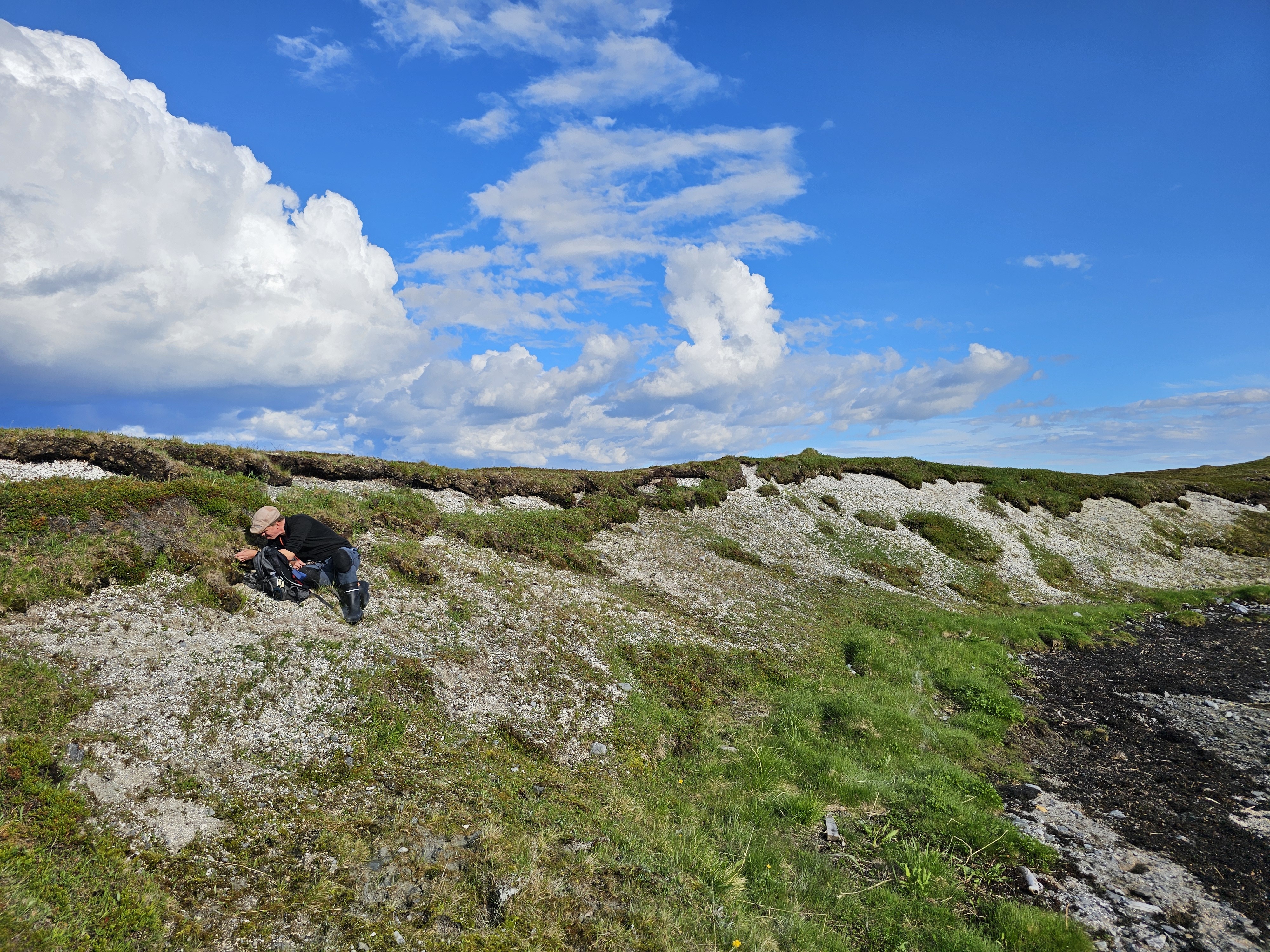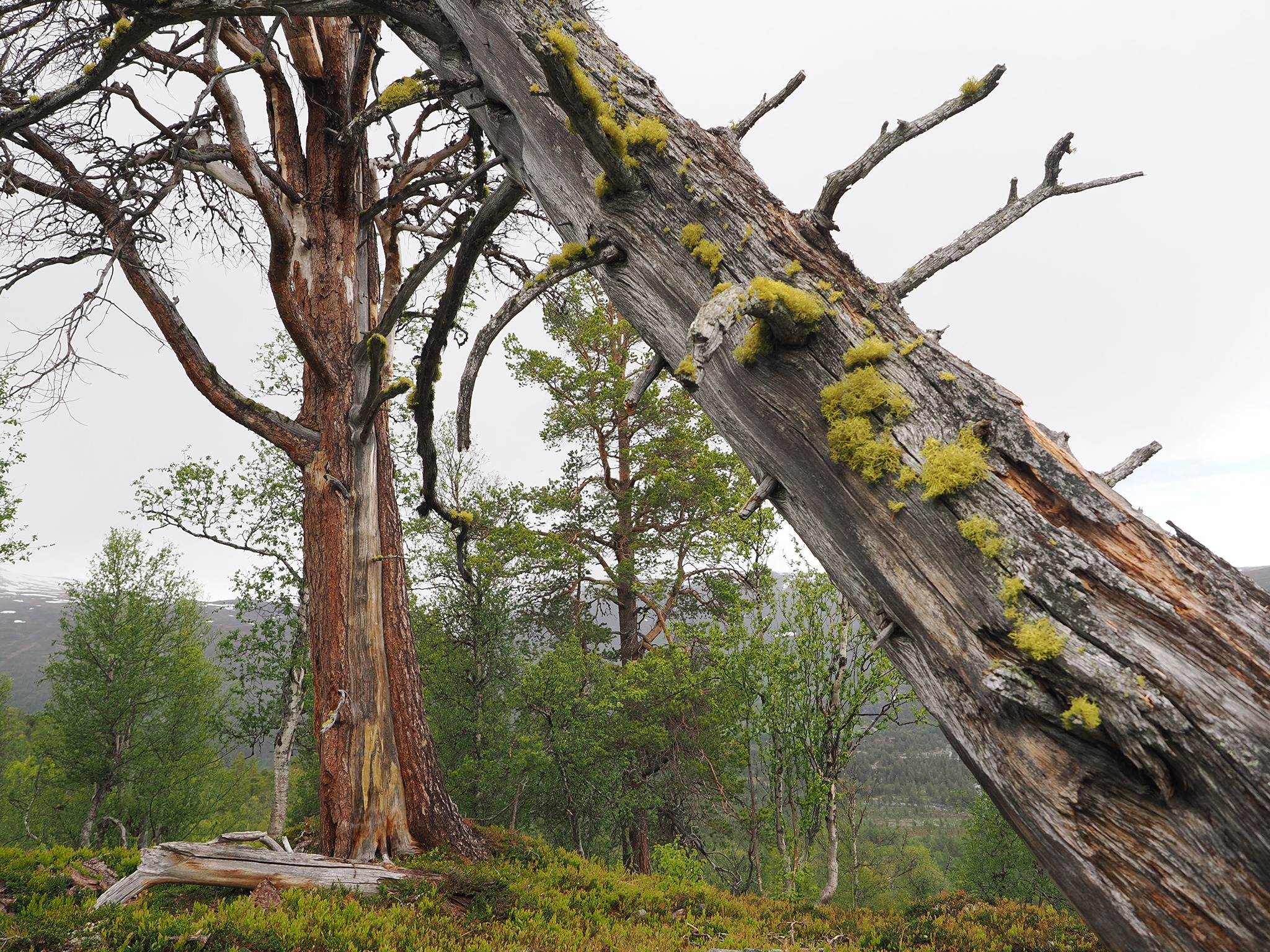Norwegian Journal of Entomology vol. 63-1 ble trykket 21. juni og er på vei til abonnentene. I dette nummeret blir det bl.a. beskrevet en fjærmygg og to sørgemygg som er nye for vitenskapen. I tillegg presenteres over 70 arter som er nye for den norske faunaen fra en rekke forskjellige grupper.
Årets første utgave av tidsskriftet vil også bli tilgjengelig på www.entomologi.no
I denne utgaven av Norwegian Journal of Entomology kan man lese følgende artikler:
—
Lissner, J. 2016. A record of Mundochthonicus styriacus Beier, 1971 (Pseudoscorpiones, Chthoniidae) in Denmark. Norwegian Journal of Entomology 63, 1–3. nje-vol63-no1-1-3-lissner.pdf (1,9 MB)
The pseudoscorpion Mundochthonius styriacus Beier, 1971 is reported new to Denmark. Recently, specimens were discovered among unidentified material in the collections of the Zoological Museum of Copenhagen. Notes on the external characters, habitat and distribution are given.
—
Fjellberg, A. & Lissner, J. 2016. Anthrenochernes stellae Lohmander, 1939 (Pseudoscorpiones, Chernetidae) new to Norway. Norwegian Journal of Entomology 63, 4–5. nje-vol63-no1-4-5-fjellberg.pdf (1,8 MB)
The first Norwegian records of Anthrenochernes stellae Lohmander, 1939 are reported from Vestfold county in hollow aspen trees. An unpublished Danish record is also given, as well as notes on associated species, ecology and distribution in Europe.
—
Aakra, K., Morka, G.H., Antonsen, A., Farlund, M., Wrånes, R.E., Frølandshagen, R., Løvbrekke, H., Furuseth, P., Fjellberg, A., Lemke, M., Pfliegler, W.P., Andersen, S., Olsen, K.M., Aadland, B. & Berggren, K. 2016. Spiders new to Norway (Arachnida, Araneae) with ecological, taxonomical and faunistic comments. Norwegian Journal of Entomology 63, 6–43. nje-vol63-no1-6-43-aakra.pdf (12,1 MB)
A total of 46 species of spiders (Araneae) are reported as new to Norway, as follows; Aculepeira lapponica (Holm, 1945), Araneus triguttatus (Fabricus, 1793) (Araneidae), Brommella falcigera (Balogh, 1935), Emblyna mitis (Thorell, 1875), Lathys humilis (Blackwall, 1855), Mastigusa macrophthalma (Kulczynski, 1897) (Dictynidae), Phaeocedus braccatus (L. Koch, 1866), Trachyzelotes pedestris (C.L. Koch, 1837) (Gnaphosidae), Acartauchenius scurrilis (O.-P. Cambridge, 1872), Aphileta misera (O. P.-Cambridge, 1882), Bolyphantes punctulatus (Holm, 1939), Centromerus semiater (L. Koch, 1879), Diastanillus pecuarius (Simon, 1884), Drepanotylus borealis Holm, 1945, Entelecara errata O. P.-Cambridge, 1913, Erigone svenssoni Holm, 1975, E. whymperi O. P.-Cambridge, 1877, Estrandia grandaeva (Keyserling, 1886), Flagelliphantes bergstroemi (Schenkel, 1931), Mughiphantes cornutus (Schenkel, 1927), Oreoneta sinuosa (Tullgren, 1955), Scotinotylus alpigena (L. Koch, 1869), Semljicola barbiger (L. Koch, 1879), S. caliginosus (Falconer, 1910), Syedra cf. apetlonensis Wunderlich, 1992, Tibioplus diversus (L. Koch, 1879), Trichoncus affinis (Kulczynski, 1894), Trichopterna cito (O. P.-Cambridge, 1872), Troxochrus cirrifrons (O. P.-Cambridge, 1871), Walckenaeria alticeps (Denis, 1952) (Linyphiidae), Aulonia albimana (Walckenaer, 1805), Pardosa saltans Töpfer-Hofmann, 2000 (Lycosidae), Ero cambridgei Kulczynski, 1911 (Mimetidae), Neon levis (Simon, 1871), N. robustus Lohmmander, 1945, Sitticus ranieri (Peckham & peckham, 1909) (Salticidae), Achaeridion conigerum (Simon, 1914), Dipoena braccata (C. L. Koch, 1841), Enoplognatha latimana Hippa & Oksala, 1982, E. serratosignata (L. Koch, 1879), Lasaeola prona (Menge, 1868), Steatoda triangulosa (Walckenaer, 1802) (Theridiidae), Theridiosoma gemmosum (L. Koch, 1877) (Theridiosomatidae), Xysticus luctator L. Koch, 1870 (Thomisidae), Zora armillata Simon, 1878 and Z. silvestris Kulczynski, 1897 (Miturgidae). The species have been collected between 2007 and 2012, with the majority having been discovered in the last couple of years. Data on their ecology, distribution and taxonomy are given. The significance of this large number of new species discovered in a relatively short time span is briefly discussed. The last checklist from 2003 reported 562 species of spiders from Norway, this paper adds significantly to that number.
—
Bello González, O.C., Andersen, T. & Hagenlund, L.K. 2016. A new species of Xestochironomus Sublette & Wirth, 1972 from Cuba (Diptera, Chironomidae). Norwegian Journal of Entomology 63, 44–49. nje-vol63-no1-44-49-gonzalez.pdf (2,0 MB)
Xestochironomus naranjoi n. sp. is described and figured based on males collected in Granma Province in eastern Cuba. The new species groups with X. nebulosus Sublette & Wirth, 1972 from Puerto Rico as it has a spatulate anal point, hooked superior volsella, forked gonostylus and brown halteres. The two species can be separated as the fork in the gonostylus is deeper in X. naranjoi and sitting more apically than in X. nebulosus, and on the color pattern as X. nebulosus has mid femur brown, mid tibia mostly yellowish, and much of abdominal tergite VIII brown; in X. naranjoi mid femur is yellowish with apical ⅓ brown, mid tibia yellowish with proximal ⅓ pale brown, and abdominal tergite VIII is all yellowish.
—
Palma, R.L. & Jensen, J.-K. 2016. Additional records of lice (Insecta, Phthiraptera) from the Faroe Islands. Norwegian Journal of Entomology 63, 50–57. nje-vol63-no1-50-57-palma.pdf (1,4 MB)
During 10 years, from 2006 to 2015, samples of parasitic lice were collected and identified from 40 species of birds and four species of mammals in the Faroe Islands, resulting in 34 new records of species and subspecies, four genera, and 20 new host-louse associations for the islands. All these data are presented in this paper. These and previously published records bring the total number of parasitic lice known from the Faroe Islands to 251 species and subspecies (239 from birds and 12 from mammals) including 13 records identified at the generic level only.
—
Nekhaeva, A.A. 2016. On the spider fauna (Arachnida, Araneae) of the Pasvik Nature Reserve (Kola Peninsula, Russia). Norwegian Journal of Entomology 63, 58–64. nje-vol63-no1-58-64-nekhaeva.pdf (2,2 MB)
The spider fauna of the Pasvik Natural Reserve (Kola Peninsula, Russia) has been studied and consists of 66 species of 12 families. Nine species – Gnaphosa orites Chamberlin, 1922, G. sticta Kulczyński, 1908, Micaria aenea Thorell, 1871, Hypsosinga albovittata (Westring, 1851), Agyneta ramosa Jackson, 1912, A. suecica Holm, 1950, Gonatium rubellum (Blackwall, 1841), Hybauchenidium ferrumequinum (Grube, 1861), Mughiphantes cornutus (Schenkel, 1927) – are reported from Kola Peninsula for the first time. Agyneta suecica Holm, 1950 is found in the spider fauna of Russia for the second time; the studied male of this species is illustrated.
—
Gjershaug, J.O., Ødegaard, F., Staverløkk, A. & Olsen, K.M. 2016. Records of bilateral gynandromorphism in three species of ants (Hymenoptera, Formicidae) in Norway. Norwegian Journal of Entomology 63, 65–70. nje-vol63-no1-65-70-gjershaug.pdf (2,3 MB)
This paper describes and illustrates three new cases of gynandromorphism in three ant species, Leptothorax kutteri Buschinger, 1965, Polyergus rufescens (Latreille, 1798) and Formica lugubris Zetterstedt, 1838. All specimens described have bilateral asymmetry, in which one side is male and one is female. Gynandromorphism is in general a very rare phenomenon. The specimens of P. rufescens and F. lugubris were collected from exceptionally warm microhabitats, a fact that might affect the probability for gynandromorphism to appear.
—
Andersen, A. 2016. On the Agromyzidae (Diptera) in Norway, Part 3 – with a check-list for Norwegian Agromyzidae. Norwegian Journal of Entomology 63, 71–95. nje-vol63-no1-71-95-andersen.pdf (11,3 MB)
The present paper comments on forty-three species belonging to four Agromyzidae genera. Nine of the species are reported new to the Norwegian fauna. The species are Agromyza marionae Griffiths, 1963, Agromyza reptans Fallén, 1823, Agromyza sulfuriceps Strobl, 1898, Liriomyza artemisicola de Meijere, 1924, Liriomyza buhri Hering, 1937, Liriomyza lutea (Meigen, 1830), Liriomyza sonchi Hendel, 1931, Liriomyza suecica Rydén, 1956, and Liriomyza virgula Frey, 1946. In addition, new regional data is given for thirty-four species previously reported from Norway. The biology of the larva, when known, and the distribution in Norway and Europe are commented on for each of the species. The Norwegian checklist for Agromyzidae now consist of 240 species.
—
Heller, K., Köhler, A., Menzel, F., Olsen, K.M. & Gammelmo, Ø. 2016. Two formerly unrecognized species of Sciaridae (Diptera) revealed by DNA barcoding. Norwegian Journal of Entomology 63, 96–115. nje-vol63-no1-96-115-heller.pdf (2,6 MB)
During a study of Norwegian Sciaridae using DNA barcoding and morphological examination, cases of cryptic diversity were detected. Cratyna uliginosoides sp. n. is distinguished from Cratyna uliginosa (Lengersdorf, 1929) and Trichosia lengersdorfi sp. n. is separated from Trichosia edwardsi (Lengersdorf, 1930) restit., which still constitutes a species complex. Barcoding proved to be an essential tool for the taxonomic resolution of cryptic species complexes. The lectotype of Rhagio morio Fabricius, 1794 syn. n. was identified as belonging to Sciara hemerobioides Scopoli, 1763, therefore Rhagio morio becomes a junior synonym of the latter and the name Trichosia morio is replaced by Trichosia caudata (Walker, 1848) restit.
—
Samin, N., Ghahari, H. & Katbeh-Badr, A. 2016. A faunistic study on the Mantodea (Insecta) from western Iran. Norwegian Journal of Entomology 63, 116–119. nje-vol63-no1-116-119-samin.pdf (1,4 MB)
This paper deals with the fauna of Mantodea in Ilam and Kermanshah provinces in western Iran. In total 8 species from 7 genera (Empusa Illiger, 1798, Ameles Burmeister, 1838, Mantis Linnaeus, 1758, Sphodromantis Stål, 1871, Microthespis Werner, 1908, Eremiaphila Lefèbvre, 1835 and Iris Saussure, 1869) and 5 families (Empusidae, Amelidae, Mantidae, Eremiaphilidae and Tarachodidae) were collected and identified. Ameles syriensis Giglio-Tos, 1915 and Eremiaphila andresi Werner, 1910 are new records for the fauna of Iran.
—
Haraldseide, H. 2016. Fourteen ichneumonid wasps (Hymenoptera, Ichneumonidae) new to Norway, Norwegian Journal of Entomology 63, 120–122. nje-vol63-no1-120-122-haraldseide.pdf (1,4 MB)
The first Norwegian records of Atractodes (Asyncrita) albovinctus Haliday, 1839, Banchus hastator (Fabricius, 1793), Ctenochira oreophila (Schmiedeknecht, 1912), Dicaelotus rufoniger Berthoumieu, 1897, Dusona mercator (Fabricius, 1793), Endasys annulatus (Habermehl, 1912), Endasys lissorulus Sawoniewicz & Luhman, 1992, Erromenus plebejus (Woldstedt, 1878), Erromenus tarsator Aubert, 1969, Glyphicnemis clypealis (Thomson, 1883), Mesoleptus devotus (Förster, 1876), Mesoleptus distinctus (Förster, 1876), Ophion perkinsi Brock, 1982 and Uchidella marginata (Kiss, 1929) are given, including short notes on distribution.





Du må være logget inn for å legge inn en kommentar.